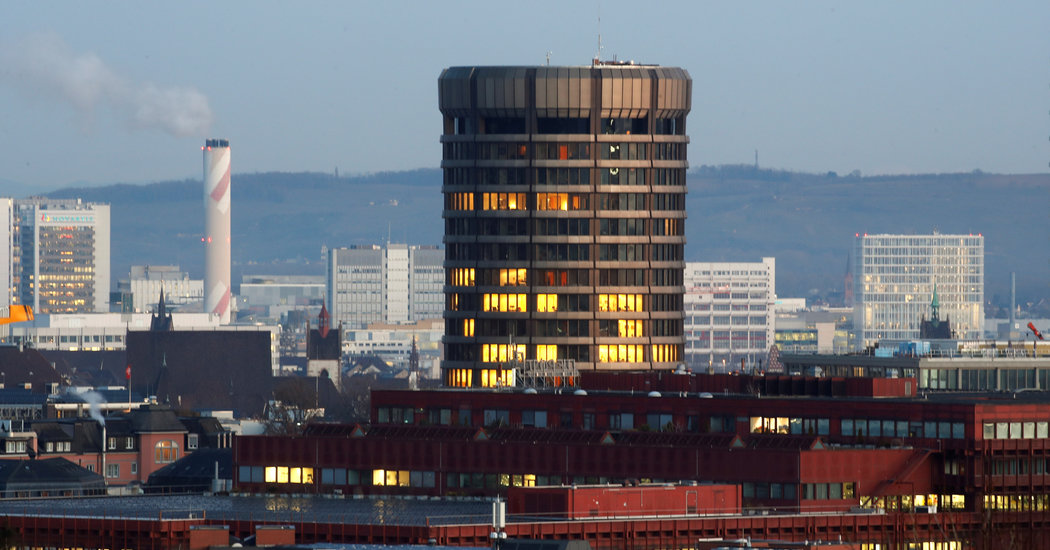MARKETING NEWS
A Truce, Not a Peace Treaty: A Global Economic Body Warns of Risks
WASHINGTON — Markets have become too complacent as risks from the coronavirus pandemic threaten global prosperity, the Bank for International Settlements warned in its annual report.“The success of central banks in calming markets and shoring up confidence has even helped spark some market exuberance,” the global group, which supports the world’s central banks, said in the Tuesday release.In a nod toward the recent disconnect between financial markets and the economy, the group said high stock prices and the lower premium on corporate debt suggested a divergence from the reality of economic weakness.“Underlying financial fragilities remain,” the group said, adding that “this feels more like a truce than a peace settlement.”The coronavirus pandemic roiled markets in March and April, as countries outside Asia began to lock down operations and it became clear that the health crisis would inflict pain upon major economies other than China’s.Central banks responded rapidly as businesses and individuals scrambled to sell assets and raise cash, and the real-world crisis began to infect financial markets — making it hard for corporations to issue debt and difficult to trade even U.S. Treasury securities, which are usually highly liquid. Monetary policymakers bought huge sums of bonds and stepped into new markets as lenders of last resort, intent on staving off a full-fledged meltdown.Investors were soothed, and they began buying stocks and debt again as they became confident that the Federal Reserve and its global counterparts stood ready to provide a backstop. Global stock indexes have rallied, and corporations have been issuing debt at a breakneck pace.But now they might be overdoing it, the Bank for International Settlements and its leaders warned.“Financial markets may have become too complacent — given that we are still at an early stage of the crisis and its fallout,” Agustín Carstens, the group’s general manager, warned in a speech tied to the release. He pointed out that the path of the virus and its effects on businesses still posed risks.“Importantly, the shock to solvency is still to be fully felt,” Mr. Carstens said, warning that banks, which have extended loans to companies and consumers, will find themselves on the hook as businesses crash, taking workers down with them. That situation, the group warned, could be “triggered by cliff effects as initial fiscal support runs out and payment moratoriums expire.”The report said that a surge in corporate defaults “is on the cards” and that such an event would “call for prompt and orderly debt restructuring,” along with other action from elected leaders with spending and lending powers.If such problems are widespread, time-consuming bankruptcies could be a poor way to deal with them.“Governments could play a useful but delicate role,” the report said. “This could range from setting some broad directions for restructuring to introducing some abbreviated, less granular processes, or possibly taking equity stakes in firms.”The report also pointed to other vulnerabilities. Thanks to the U.S. dollar’s dominance in global commerce and finance, the Federal Reserve had to step in to calm global funding markets as conditions deteriorated in March.The “huge scale” of the Fed response points to a vulnerability in the global monetary and financial system “when contrasted with the much smaller firepower of international organizations” like the International Monetary Fund, the report said. It said emerging market economies must rely on a “fragmented combination of mechanisms” to meet their liquidity needs in times of crisis until a “lasting political and practical solution” is found.
Updated June 30, 2020
What are the symptoms of coronavirus?
Common symptoms include fever, a dry cough, fatigue and difficulty breathing or shortness of breath. Some of these symptoms overlap with those of the flu, making detection difficult, but runny noses and stuffy sinuses are less common. The C.D.C. has also added chills, muscle pain, sore throat, headache and a new loss of the sense of taste or smell as symptoms to look out for. Most people fall ill five to seven days after exposure, but symptoms may appear in as few as two days or as many as 14 days.
Is it harder to exercise while wearing a mask?
A commentary published this month on the website of the British Journal of Sports Medicine points out that covering your face during exercise “comes with issues of potential breathing restriction and discomfort” and requires “balancing benefits versus possible adverse events.” Masks do alter exercise, says Cedric X. Bryant, the president and chief science officer of the American Council on Exercise, a nonprofit organization that funds exercise research and certifies fitness professionals. “In my personal experience,” he says, “heart rates are higher at the same relative intensity when you wear a mask.” Some people also could experience lightheadedness during familiar workouts while masked, says Len Kravitz, a professor of exercise science at the University of New Mexico.
I’ve heard about a treatment called dexamethasone. Does it work?
The steroid, dexamethasone, is the first treatment shown to reduce mortality in severely ill patients, according to scientists in Britain. The drug appears to reduce inflammation caused by the immune system, protecting the tissues. In the study, dexamethasone reduced deaths of patients on ventilators by one-third, and deaths of patients on oxygen by one-fifth.
What is pandemic paid leave?
The coronavirus emergency relief package gives many American workers paid leave if they need to take time off because of the virus. It gives qualified workers two weeks of paid sick leave if they are ill, quarantined or seeking diagnosis or preventive care for coronavirus, or if they are caring for sick family members. It gives 12 weeks of paid leave to people caring for children whose schools are closed or whose child care provider is unavailable because of the coronavirus. It is the first time the United States has had widespread federally mandated paid leave, and includes people who don’t typically get such benefits, like part-time and gig economy workers. But the measure excludes at least half of private-sector workers, including those at the country’s largest employers, and gives small employers significant leeway to deny leave.
Does asymptomatic transmission of Covid-19 happen?
So far, the evidence seems to show it does. A widely cited paper published in April suggests that people are most infectious about two days before the onset of coronavirus symptoms and estimated that 44 percent of new infections were a result of transmission from people who were not yet showing symptoms. Recently, a top expert at the World Health Organization stated that transmission of the coronavirus by people who did not have symptoms was “very rare,” but she later walked back that statement.
What’s the risk of catching coronavirus from a surface?
Touching contaminated objects and then infecting ourselves with the germs is not typically how the virus spreads. But it can happen. A number of studies of flu, rhinovirus, coronavirus and other microbes have shown that respiratory illnesses, including the new coronavirus, can spread by touching contaminated surfaces, particularly in places like day care centers, offices and hospitals. But a long chain of events has to happen for the disease to spread that way. The best way to protect yourself from coronavirus — whether it’s surface transmission or close human contact — is still social distancing, washing your hands, not touching your face and wearing masks.
How does blood type influence coronavirus?
A study by European scientists is the first to document a strong statistical link between genetic variations and Covid-19, the illness caused by the coronavirus. Having Type A blood was linked to a 50 percent increase in the likelihood that a patient would need to get oxygen or to go on a ventilator, according to the new study.
How many people have lost their jobs due to coronavirus in the U.S.?
The unemployment rate fell to 13.3 percent in May, the Labor Department said on June 5, an unexpected improvement in the nation’s job market as hiring rebounded faster than economists expected. Economists had forecast the unemployment rate to increase to as much as 20 percent, after it hit 14.7 percent in April, which was the highest since the government began keeping official statistics after World War II. But the unemployment rate dipped instead, with employers adding 2.5 million jobs, after more than 20 million jobs were lost in April.
How can I protect myself while flying?
If air travel is unavoidable, there are some steps you can take to protect yourself. Most important: Wash your hands often, and stop touching your face. If possible, choose a window seat. A study from Emory University found that during flu season, the safest place to sit on a plane is by a window, as people sitting in window seats had less contact with potentially sick people. Disinfect hard surfaces. When you get to your seat and your hands are clean, use disinfecting wipes to clean the hard surfaces at your seat like the head and arm rest, the seatbelt buckle, the remote, screen, seat back pocket and the tray table. If the seat is hard and nonporous or leather or pleather, you can wipe that down, too. (Using wipes on upholstered seats could lead to a wet seat and spreading of germs rather than killing them.)
What should I do if I feel sick?
If you’ve been exposed to the coronavirus or think you have, and have a fever or symptoms like a cough or difficulty breathing, call a doctor. They should give you advice on whether you should be tested, how to get tested, and how to seek medical treatment without potentially infecting or exposing others.
Mr. Carstens also urged central bankers to fix vulnerabilities in the financial sector outside the banking system, known as shadow banking.While global regulators strengthened banks after the 2008 financial crisis, now “they need to help ensure that the nonbank financial sector optimally supports the real economy over the medium term,” he said.If there is good news, according to the Bank for International Settlements, it is that formal banks — both the origin and the amplifier of the 2008 crisis — have performed better this time around, absorbing big balance sheet inflows and meeting credit line drawdowns, in some cases with the help of regulatory easing.“A silver lining in this sobering picture is the state of the banking system,” the report said. “The pandemic found banks much better capitalized and more liquid, thanks largely to the post-crisis financial reforms coupled with a more subdued expansion.”The Fed released the results of its annual stress tests last week, showing that large banks in America are prepared to sustain a shock but that a substantial chunk of them — about a quarter — will bump up against or even breach their capital minimums if the economy experiences a second pandemic wave and double-dip recession.The Fed stopped short of barring banks from paying dividends next quarter, as some lawmakers and former regulators have urged — a decision that drew public criticism from one of the Fed’s governors, Lael Brainard, who said not taking stronger measures could “impair the recovery.”
Source link













